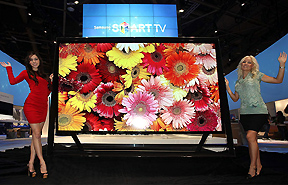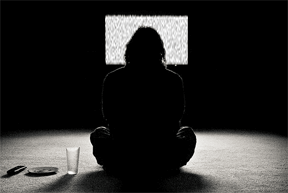Wednesday 21 May, 2014, 20:02 - Broadcasting, Spectrum Management
 It could be argued that before the switch-over from analogue to digital television broadcasting, the value of terrestrial broadcasting was on the decline. Faced with fierce competition from cable and satellite, each offering 10 or more times the number of programmes, terrestrial television was a poor cousin whose main use was often to deliver public service broadcasting and, through general interest obligations imposed by national governments, to provide an accessible (free-to-air) service to 95% or more of a country's population (measured both geographically and demographically).
It could be argued that before the switch-over from analogue to digital television broadcasting, the value of terrestrial broadcasting was on the decline. Faced with fierce competition from cable and satellite, each offering 10 or more times the number of programmes, terrestrial television was a poor cousin whose main use was often to deliver public service broadcasting and, through general interest obligations imposed by national governments, to provide an accessible (free-to-air) service to 95% or more of a country's population (measured both geographically and demographically).As digital switch-over has taken hold, terrestrial broadcasting has had a repreive and is now able to offer true multi-channel television. Where previously it was only possible to broadcast a single television station on a single frequency, that frequency can now hold 10 or more standard definition (SD) channels, or 4 or 5 HD channels. Where there may have been 6 analogue stations on air, there can now be upwards of 60 stations. In many cases, 60 stations is enough for the average viewer and the bouquets of channels offered on cable or satellite may now begin to seem expensive compared to free-to-air DTT. In many countries the draw of cable and satellite TV is no longer the sheer variety of channels available, but the premium content that is on offer. Pay-TV services offering sport and movies continue to be popular, but such premium content is not usually available on DTT. Nonetheless, for many viewers DTT is perfectly sufficient.
 But just as digital terrestrial TV (DTT) has had a new lease of life, the other broadcasting platforms are once again biting at its heels with new service offerings. Whilst 3D television seems to have taken a back seat for the time being, new, even higher definition television, is stepping to the fore. Ultra-High Definition (UHD) has twice the resolution of standard HD and large UHD televisions are already on show and on sale in many retailers. At present there is minimal UHD content, however a hand full of new UHD channels are being launched and, for example, the World Cup football in Brazil will be broadcast in UHD.
But just as digital terrestrial TV (DTT) has had a new lease of life, the other broadcasting platforms are once again biting at its heels with new service offerings. Whilst 3D television seems to have taken a back seat for the time being, new, even higher definition television, is stepping to the fore. Ultra-High Definition (UHD) has twice the resolution of standard HD and large UHD televisions are already on show and on sale in many retailers. At present there is minimal UHD content, however a hand full of new UHD channels are being launched and, for example, the World Cup football in Brazil will be broadcast in UHD. To be able to see the difference that UHD makes compared to standard HD, a very large television set is needed (42 inches or greater) and it could therefore be argued that UHD will always be a niche product. Then again, many broadcasters believed that HD would be a niche, but it is becoming the de facto standard and average television sizes are on the increase.
Technically speaking, UHD requires a bit-rate of around 20 Mbps. Whilst such bit rates are relatively easy for cable and satellite networks to deliver, broadcasting UHD over DTT would require at least half of a DVB-T2 multiplex, and the most advanced video (HEVC) codecs. In practice this means that were a terrestrial frequency currently carries 10 or more SD, or 4 or 5 HD channels, it might, at best, be able to offer 2 UHD channels.
 But that is not the end of the story. Just around the corner is super-high vision (SHV), sometimes called 8K, which once again doubles the resolution of the picture compared to UHV. SHV will require around 75 Mbps to be broadcast and at this point, whilst cable and satellite are still in the game, DTT is no longer able to broadcast even a single programme on a single frequency (without very complex transmitter and receiver arrangements that would require, for example, householders to install new, and potentially more than one, antenna). Of course to benefit from SHV, an even larger TV screen will be necessary, but with the growth in home cinema, it is can perhaps be expected that in time, a goodly proportion of homes will want access to material in this super high resolution.
But that is not the end of the story. Just around the corner is super-high vision (SHV), sometimes called 8K, which once again doubles the resolution of the picture compared to UHV. SHV will require around 75 Mbps to be broadcast and at this point, whilst cable and satellite are still in the game, DTT is no longer able to broadcast even a single programme on a single frequency (without very complex transmitter and receiver arrangements that would require, for example, householders to install new, and potentially more than one, antenna). Of course to benefit from SHV, an even larger TV screen will be necessary, but with the growth in home cinema, it is can perhaps be expected that in time, a goodly proportion of homes will want access to material in this super high resolution.So where does that leave DTT? Arguably, within a few years, it will once again be unable to compete with the sheer girth of the bandwidth pipe that will be provided by cable and satellite networks. It's probably worth noting at this point that most IP-based video services (with the possible exception of those delivered by fiber-to-the-home) will also be unable to deliver live SHV content. This time there will be no reprieve for DTT as it simply does not have the capacity to deliver these higher definition services.
What is therefore to be done with DTT? Is it necessary to provide continued public service, universal access, free-to-air services that were the drivers for the original terrestrial television networks? Is its role to provide increased local content which might be uneconomic to broadcast over wide areas? Should it be used to deliver broadcast content to mobile devices where it has more than sufficient capacity to provide the resolution needed for smaller screens? Or, should it be turned off completely, and the spectrum it occupies be given over to something or someone else?
In countries where cable and satellite penetration is already high, there is arguably nothing much to lose by switching DTT off. In Germany, for example, RTL have already withdrawn from the DTT platform and there is talk of turning off the service completely. In countries that have not yet made the switch-over, it might be more cost effective to make the digital switch-over one that migrates to satellite (and cable where available) than to invest in soon-to-be-obsolete DTT transmitters.
 Broadcasters should be largely agnostic to the closure of DTT. After all, their business is producing content and as long as it reaches the audiences, they ought not to care what the delivery mechanism is. Other radio spectrum users (e.g. mobile phones, governments) would surely welcome the additional spectrum that would become available. So who loses? Those companies who currently provide and operate the DTT transmitter networks, such as Arqiva in the UK, Teracom in Sweden and Digitenne in the Netherlands, who stand to lose multi-million pound (or Euro) contracts. For these organisations the stakes are high, but even the most humble economist would surely admit that the benefits elsewhere outweigh the costs. So let's turn off DTT - not necessarily today - but isn't it time to plan for a 'digital switch-off' to follow the 'digital switch-over'?
Broadcasters should be largely agnostic to the closure of DTT. After all, their business is producing content and as long as it reaches the audiences, they ought not to care what the delivery mechanism is. Other radio spectrum users (e.g. mobile phones, governments) would surely welcome the additional spectrum that would become available. So who loses? Those companies who currently provide and operate the DTT transmitter networks, such as Arqiva in the UK, Teracom in Sweden and Digitenne in the Netherlands, who stand to lose multi-million pound (or Euro) contracts. For these organisations the stakes are high, but even the most humble economist would surely admit that the benefits elsewhere outweigh the costs. So let's turn off DTT - not necessarily today - but isn't it time to plan for a 'digital switch-off' to follow the 'digital switch-over'?